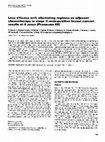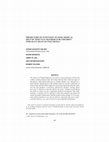Papers by CESAR ANTONIO OSPINA GALVEZ

International Journal of Electrical Power & Energy Systems, 2017
Abstract Fault location is a necessity to realize the self-healing concept of modern distribution... more Abstract Fault location is a necessity to realize the self-healing concept of modern distribution networks. This paper presents a novel fault location method for distribution networks with distributed generation (DG) using measurements recorded at the main substation and at the DG terminals. The proposed method is based on an iterative load flow algorithm, which considers the synchronization angle as an unknown variable to be estimated. Therefore, it obviates the need of synchronized measurements. A new fault location equation is also proposed which is valid for all different fault types, hence the fault type information is not required. The developed method can be simply implemented by minor modifications in any distribution load flow algorithm and it is applicable to different distribution network configurations. The accuracy of the method is verified by simulation studies on a practical 98-node test feeder with several DG units.
Moche: propuestas y perspectivas
INTRODUCCIÓN Las excavaciones realizadas entre 1990 y 1992 en la Huaca Cao Viejo del Complejo El ... more INTRODUCCIÓN Las excavaciones realizadas entre 1990 y 1992 en la Huaca Cao Viejo del Complejo El Brujo, valle de Chicama, han permitido establecer de modo preliminar cuatro fases constructivas que involucran la utilización de distintos tipos de adobe. En la tercera y cuarta fases, el edificio fue construido con adobes altos que presentan marcas de fabricantes, y decorado con relieves polícromos. La última fachada de la huaca representa el esplendor formal y mayor complejidad decorativa a fine..
American Fitness, Sep 1, 1998

Perspectives on health from the Bible such as biblical anthropology and the laws of God, as a bas... more Perspectives on health from the Bible such as biblical anthropology and the laws of God, as a basis for health and disease dynamics, are receiving support from science. Biblical anthropology teaches that a human being is a whole person, with physical, mental, social, ecological and spiritual dimensions. The body is not the opposite of the soul, it is its visible expression. One dimension affects the other dimensions, because a human being is a unit. Scientific studies show many connections between mind and body, such as aerobic exercise and memory, the effect of one body system on another, and even spirituality and disease. Health and disease are the result of obedience or disobedience to God's laws. Research in the area of behavioral epidemiology shows links between lifestyle and diseases such as cancer and heart disease. Biblical perspectives provide a useful theoretical framework for public health practice and research. Science and faith have traditionally been in disagreemen...

The major causes of death in the world are heart attack, stroke, and cancer. The main contributin... more The major causes of death in the world are heart attack, stroke, and cancer. The main contributing factors for chronic diseases complications are unhealthy behaviors; so, health behavior change has become imperative in the world today. There are several models and theories for health behavior change. They are, however, far from public reach because they are not easy for people to understand and apply in their daily lives. The seven-step model (7SM) is the result of integrating key constructs from different theories and models and putting them in a way that the public may understand and apply. The model has seven steps that individuals, families, and small groups can use to change behavior, and three more tools for maintenance. An exploratory study done in the Philippines and Peru with graduate students from 30 different countries shows the potential of the 7SM in changing different unhealthy behaviors and installing new healthy behaviors.
Objective: To determine the influence of knowledge on protective attitudes and practices against ... more Objective: To determine the influence of knowledge on protective attitudes and practices against the risk of HIV/AIDS in Peruvian students from exclusively private schools from the three regions of the country. Methodology: Following a correlational-comparative design, a sample of 849 Peruvian students from 52 private high schools was selected using cluster, stratified, and systematic sampling. Data was collected from adolescents and parents who signed informed consents, and was analyzed using the Kruskal-Wallis test and Spearman correlations. Results: Results indicate that the level of knowledge influences attitudes but not protective practices against the risk of HIV/AIDS (r =.218, pConclusions: Private school students’ knowledge about HIV/AIDS shows a highly significant influence (pKeywords: HIV/AIDS; protective attitudes & practices; private high schools.

The 6 th of the 8 United Nations Millennium Development Goals is to combat HIV/AIDS, which affect... more The 6 th of the 8 United Nations Millennium Development Goals is to combat HIV/AIDS, which affects the fulfillment of 4 other goals. Combating HIV/AIDS depends on effective sex education and the care of AIDS patients across countries, cultures, and all kinds of boundaries. Is religion a protective factor against HIV/AIDS, or is it a barrier? Literature is divided on this issue. The purpose of this study was to determine the influence of religiosity on attitudes and protective practices against the risk of HIV/AIDS in 849 Peruvian students from 52 private schools in the 3 cities: Lima, Cuzco and Iquitos. Results showed that the level of religiosity and attitudes are not significantly related, but religion did encourage protective practices against the risk of HIV/AIDS (r = .059, p > .05, r = -.156 p < 0.01). This establishes a low relationship between religiosity and protective practices against the risk of HIV/AIDS. Attitudes were also found to have a highly significant correl...
Pathobiology, 2015
We present the histopathological findings of a naturally mummified eye from the Peruvian Lambayeq... more We present the histopathological findings of a naturally mummified eye from the Peruvian Lambayeque culture (900-1,200 AD), in which rehydration, light microscopy, and scanning electron microscopy allowed a detailed analysis of several eye tissues including the eyelids, sclera, and optic nerve, the latter showing evidence of hemorrhage likely related to the documented strangulation as the cause of death. We conclude that histopathological analysis of rehydrated mummified tissues can provide valuable information from fragile eye structures including the optic nerve, and these findings can be useful from a forensic point of view.

British Journal of Cancer, 1997
and cooperating investigators Cramer 1180-(1426), Buenos Aires, Argentina Summary A randomized tr... more and cooperating investigators Cramer 1180-(1426), Buenos Aires, Argentina Summary A randomized trial to compare adjuvant treatment with an alternating regimen with conventional chemotherapy was performed. A total of 589 node-positive patients were included and stratified according to number of positive nodes (N1-3 and N > 4) and menopausal status. Premenopausal Ni-3 patients were randomized to cyclophosphamide, methotrexate and fluorouracil (CMF) or CMF/4'-epirubicin, cyclophosphamide (EC), post-menopausal N1-3 patients to fluorouracil, 4 epirubicin, cyclophosphamide (FEC) or CMF/EC and pre-and postmenopausal patients with N. 4 to fluorouracil, 4' epirubicin, cyclophosphamide, methotrexate, prednisone (FECMP) or CMF/EC. In premenopausal patients, CMF was superior to CMF/EC in terms of disease-free survival (DFS) (65% vs 45%, P= 0.0149) and survival (72.3% vs 50.2%, P = 0.0220) whereas, for N 2 4 patients, differences between FECMP and CMF/EC did not achieve statistical significance (DFS 35% vs 26.2%; survival 50% vs 38.1%, P = NS). For post-menopausal patients, FEC was superior to CMF/EC in DFS (58.6% vs 36.8%, P = 0.0215) and survival (66.2% vs 46%, P = 0.0155). In post-menopausal patients with N > 4, differences favouring CMF/EC were significant in DFS (40.4% vs 22%, P = 0.0371) but not in survival (47.4% vs 32.2%, P = 0.1185). Alternating regimens did not offer better results in premenopausal and post-menopausal N1-3 patients. Results regarding post-menopausal N > 4 women require further confirmation.

The International Quarterly of Community Health Education, 2001
The Theory of Planned Behavior was used to assess predictors of Peruvian mothers seeking medical ... more The Theory of Planned Behavior was used to assess predictors of Peruvian mothers seeking medical help when they believed their child had signs of pneumonia. Open-ended interviews to identify beliefs were followed by a questionnaire administered to 500 mothers from low-income settlements in Lima in June and July 2000. Subjective norm (what important referents want) was the best predictor of intention, followed by mothers' feelings about how easy it would be to take the child to the clinic. Attitude toward taking the child to a clinic was not a significant predictor of intention. This study indicates a stronger role for subjective norm than attitudes and perceived control in similar studies done with this model in other settings. It, of course, only predicts intention to act and not behavior, important here given social-economic barriers, e.g., cost, to access to care among this study group.

TrAC Trends in Analytical Chemistry, 2013
ABSTRACT A review. Since the first coupling of laser-ablation inductively-coupled plasma to mass ... more ABSTRACT A review. Since the first coupling of laser-ablation inductively-coupled plasma to mass spectrometry (LA-ICP-MS) in 1985, applications of this anal. technique in various scientific fields have been developed. LA-ICP-MS is an elemental and isotopic microanal. technique that is increasingly used for routine anal. in forensic labs. around the world due to its great discriminating power between samples and its capacity for analyzing solid evidence of small size. In addn., its quasi-non-destructive character is esp. welcome for this type of sample. The main forensic applications of LA-ICP-MS have been developed for glass and paint samples. However, applications to other samples have also been reported [e.g., documents (ink and paper), fibers, cannabis, gems, Australian ocher and porcelain, brick stones, and gold and silver]. In the forensic field, the adjustment of instrumental anal. parameters, the study of interferences produced by fractionation and polyat. ions, and the statistical treatment of dat

Revista Panamericana de Salud Pública, 2002
Objective. To assess Peruvian mothers' knowledge and recognition of pneumonia in children under 5... more Objective. To assess Peruvian mothers' knowledge and recognition of pneumonia in children under 5 years of age, the mothers' attitude toward seeking medical help if they had a child with signs of pneumonia, and their perception of a Government of Peru pneumonia campaign. Methods. In this cross-sectional study, 501 mothers were selected randomly from 20 lowincome communities of the metropolitan area of Lima, Peru, and were interviewed between June and August 2000. Using SPSS software, descriptive statistics were applied to summarize the demographic data and the data regarding the mothers' knowledge of pneumonia and recognition of signs of the disease. Cross-tabulations and chi-squares were done to assess relationships between variables and to make comparisons. Results. About 84% of the mothers said that they knew what pneumonia is. Most believed that pneumonia is dangerous. A majority (58.7%) indicated that pneumonia is caused by lack of parental care. Only 28.9% believed that a virus causes the disease. More than 80% correctly picked rapid breathing and/or chest retraction from a list of possible signs and symptoms of pneumonia, and 94.6% said they were ready to take their child to the closest health center if they thought their child had pneumonia. Although 57.1% said they had heard about the Government of Peru pneumonia campaign, 69.3% of these mothers said they could not recall the motto of the campaign. Mothers who reported having heard of the campaign through TV were more likely than other mothers to correctly recognize the two major signs of pneumonia presented in the campaign. Conclusions. Although the percentage of mothers believing they can recognize pneumonia through rapid breathing and chest retraction seems to have increased in recent years, there is still a sizable percentage of mothers who remain uninformed about pneumonia and its possible fatal consequences. Efforts need to continue to educate Peruvian mothers about the causes, recognition of the signs, and treatment of pneumonia. The results suggest that the Government of Peru pneumonia campaign should use television much more, as well as the health centers, where most of the mothers receive medical attention and health information. Respiratory tract infections; children's health; health education; knowledge, attitudes, practice; Peru.
Nano Letters, 2002
Several water-soluble cobalt(III) complexes were employed as precursors to form cobalt oxide nano... more Several water-soluble cobalt(III) complexes were employed as precursors to form cobalt oxide nanostructures. These complexes were incorporated into polyelectrolyte multilayers precoated onto colloidal particles, followed by calcination. Cobalt complexes with strong intermolecular hydrogen bonding form one-dimensional Co 3 O 4 nanotube structures. Short Co 3 O 4 nanotubes with defects and broken spheres are formed when cobalt complexes with weak or no intermolecular hydrogen bonding are used. The sites for disulfide bond formation present on some complexes were found to be unessential for the nanotube formation.
Journal of the American Chemical Society

Global Health Promotion, 2010
Con el propósito de forenar los primeros agentes comunitarios de salud (ACES) del Centro Poblado ... more Con el propósito de forenar los primeros agentes comunitarios de salud (ACES) del Centro Poblado Virgen del Carmen La Era, Lima, Perú, se realizó un programa de entrenamiento educacional en las áreas de prevención de enfermedades diarreicas agudas (EDAS) infantiles, sexualidad saludable para adolescentes y autocuidado de la salud del adulto mayor. Un grupo de 32 ciudadanos fueron seleccionados por el Ministerio de Salud y la directiva del poblado en el 2006, y capacitados por un equipo interdisciplinario de profesionales de la Universidad Peruana Unión (UPeU) de Lima y Loma Linda University de California, con la finalidad de mejorar el acceso de 5,248 habitantes a la promoción y cuidado de salud. El Programa educacional “Por una Era Saludable” empleó técnicas educativas como rescate de saberes previos, dinámicas de autoestima, demostraciones de actividad física y juego de roles, y culminó con una visita domiciliaria por los ACES para aplicar sus nuevas destrezas. El resultado fue ev...










Uploads
Papers by CESAR ANTONIO OSPINA GALVEZ